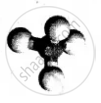Advertisements
Advertisements
प्रश्न
Differentiate between the following with suitable examples- A basic radical and an acid radical
उत्तर
The positive part is called the basic radical and the negative part is called the acid radical.
A compound maybe consider having –
- A positive part [e.g. metal or ammonium ion]
- A negative part [e.g. chloride, bromide, sulphate, nitrate etc.]
| Compound | Positive part - Basic Radical | Negative part - Acid radical |
| Sodium | \[\ce{Na+}\] | \[\ce{NO3-}\] |
| Ammonium | \[\ce{NH4+}\] | `"SO"_4^--` |
| Sulphate |
\[\begin{bmatrix} |
|
|
|
APPEARS IN
संबंधित प्रश्न
What is the name of a particle which contains 10 electrons, 11 protons and 12 neutrons ?
Name the particle which has 18 electrons, 18 neutrons and 17 protons in it.
Fill in the following blank with suitable word:
The particle which is formed by the loss or gain of electrons by an atom is called..............
Explain the formation of (i) sodium ion, and (ii) chloride ion, from their respective atoms giving the number of protons and number of electrons in each one of them. What is the reason for positive charge on a sodium ion and a negative charge on a chloride ion ?
The valencies (or charges) of some of the ions are given below :
| Ion | Valency (Charge) | Ion | Valency (Charge) |
| Sodium ion | 1+ | Bromide ion | 1– |
| Ammonium ion | 1+ | Hydroxide ion | 1– |
| Calcium ion | 2+ | Sulphate ion | 2– |
| Lead ion | 2+ | Phosphate ion | 3– |
Using this information, write down the formulae of the following compounds :
(i) Sodium phosphate
(ii) Ammonium sulphate
(iii) Calcium hydroxide
(iv) Lead bromide
Give example.
Basic radicals
Give example.
Trivalent basic radicals
Write the basic radicals and acidic radicals of the following and then write the chemical formulae of these compound.
Chromium sulphate
Write the basic radicals and acidic radicals of the following and then write the chemical formulae of these compound.
Magnesium phosphate
State if the following element or radical is divalent?
Chromium

